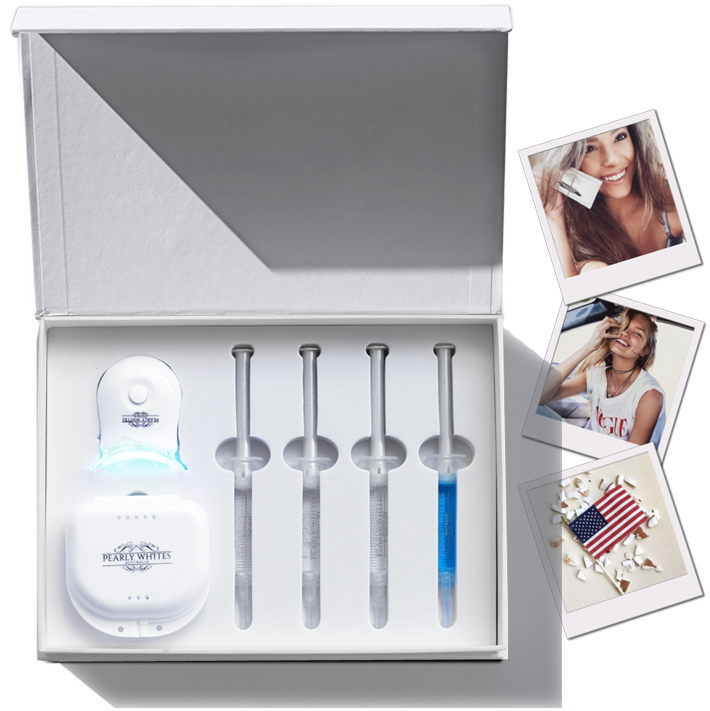The Best Ways to Whiten Teeth

How Teeth Whitening Works
Most tooth whitening products contain dental-safe bleach (hydrogen peroxide or carbamide peroxide). Dental bleaching removes stains by using the chemicals to break down stubborn teeth stains, breaking up the discoloration and leaving your teeth looking whiter.
There are a number of factors that may be responsible for staining teeth while some people are genetically predisposed to darker teeth. Most people find that they get yellow teeth as they age as their thinning tooth surfaces begin to show the darker dentin underneath. Lifestyle choices such as poor dental hygiene, smoking, coffee and red wine all contribute to discoloration. Tooth decay, gum disease, some medications, certain antibiotics, and trauma can also cause teeth to look darker.
Good oral care, including regular brushing, flossing your teeth, and dental checkups and teeth cleanings, will go some way towards helping remove the surface stains. Whitening toothpaste can also help you get whiter teeth, up to one shade lighter. If you want to see significant results you’ll need to choose an option that really removes stains from the enamel on your teeth such as in-chair treatments and whitening kits.
What's the Best Way to Whiten Teeth?

The best way to whiten teeth is one that is safe, cost-effective and works for you. Everyone’s teeth are different and there are different types of tooth stains, some of which respond very well to teeth whitening and some that don’t.
If you have yellow teeth due to stains from food, drink or aging then whitening trays or in-office dental bleaching should help to restore your smile by making your teeth several shades lighter. If you have grey or brown discoloration, oral health problems, dental restorations or certain diseases you will need to discuss your teeth whitening options with a dentist.
Most Cost-effective Way to Whiten Teeth
You can now get a high level of teeth whitening by using dentist-quality formulas at home. Costing $100-$200, an OTC whitening kit is a cost-effective way to whiten teeth compared to in-office bleaching at $500 to $1000 per treatment or dentist dispensed take-home trays at $400. Add to this the fact that once you have the whitening kit you only have to buy more gel and the cost over time comes down even further.
Buy a Pearly Whites At-home Teeth whitening kit online for $ 99.95 $ 1,190.95, that's $ -1,091 off.

Which Teeth Whitening Method is the Right One for You?
The best teeth whitening option depends on a few factors:
Why your teeth are discolored: The common reasons for teeth turning yellow are age, food/drink staining and smoking. These are all good candidates for teeth whitening treatments. It’s important to note that not all tooth staining can be treated with dental bleaching. Some causes of discoloration, such as trauma, medications, medical treatments, disease or dental work may require a different solution like dental veneers.
How fast you want whiter teeth: Chairside treatments are definitely the fastest dental whitening method as the product that’s used has a higher percentage of HP/CP than home use products are allowed to have.
Your budget: In-chair treatments will set you back anywhere from $500 to $1000 depending on the type of treatment and where you have it done. By comparison, take home trays from the dentist’s office costs around $400 while over the counter whitening trays are priced from $100.
Your schedule: If your schedule allows you to make and keep dental bleaching appointments then in-chair treatments are a good option. Those with hectic schedules who can’t afford the hour-long visit to the dentist (plus travel time) might prefer the ability to whiten in their home at a time that’s convenient for them, while still being able to do other things.
Pro Tip: Whichever whitening method you choose, make sure you start with a visit to your dentist for an exam and thorough cleaning. This will give you the best chance at achieving good results.
What You Should Know Before You Start
- Teeth whitening isn’t permanent, our teeth yellow as we age and much of what we eat and drink contributes to the discoloration of our teeth. Good oral care, whitening toothpaste, regular visits to the dental hygienist, and repeat whitening treatments will help to keep your teeth white.
- Teeth whitening doesn’t work for everyone and some people just shouldn’t whiten their teeth. Read on to find out more or talk to your dentist if you are concerned about your suitability.
- Dental bleaching may cause temporary sensitivity of the teeth and gums. This will normally subside within 24 hours and can usually be prevented by following the instructions closely.
- Teeth whitening products are not drugs and therefore aren’t regulated by the FDA.
How to Whiten Your Teeth at Home

You can whiten your teeth at home by using:
- DIY Home Remedies: Orange peels, turmeric, apple cider vinegar, pineapples, lemon juice and baking soda, baking soda and hydrogen peroxide, smashed strawberries, coconut oil pulling and a number of other DIY remedies and supposedly natural whiteners have become popular online. While some are harmless, those that are acidic or abrasive can wear away the enamel on your teeth. For most home remedies there is currently no evidence that they produce significant teeth whitening results, although some do have anti-bacterial properties.
- Whitening Toothpaste: Sold online, in drugstores and supermarkets. Whitening toothpaste contains mild abrasives and polishing agents that help to break down and remove the plaque and surface stains on your enamel. With continuous use they can lighten your teeth by up to one shade. This is a good option for those with good oral health and fairly white teeth.
- Whitening Strips: Teeth whitening strips come in many different styles, colors and even flavors. Pricing varies widely as does the strength of the active ingredients. Some strips use bleaching agents (hydrogen peroxide or carbamide peroxide) while others use gentler ingredients. The latter is potentially a good option for people with sensitive teeth or gums.
- Dentist Dispensed or Over the Counter Kits: You can purchase a take-home kit from your dentist or buy an OTC whitening kit online, at beauty salons and drug stores. Both types of kits contain whitening trays and gel that contains a safe bleaching agent. The strength of the bleaching agent will vary as will the amount of gel included. Some kits, like the Pearly Whites Professional Teeth Whitening Kit, also contain desensitization gel, LED lights and tray cases. Bleaching kits are a good at home whitening option for those that want to lighten their teeth by several shades.
Using a Teeth Whitening Kit
Before you start the whitening treatment thoroughly brush and floss your teeth to remove any particles. Next carefully read the instructions. Although each kit will be slightly different, the instructions will be similar to:
- Place a small amount of whitening gel on each tooth crevice on the trays.
- Place the top and bottom whitening trays in your mouth.
- Ensure they fit snuggly and that no gel is seeping onto your gums.
- Keep the trays in for the amount of time recommended in the instructions.
- Remove the trays, rinse them thoroughly and brush them with toothpaste.
- Rinse your mouth and brush your teeth well.
- Use the shade guide to chart your progress.
- Repeat the treatment as often as required but NOT more often than the instructions recommend.
- Store your trays and the remaining gel in a safe, clean place out of the reach of children.
Use Teeth Whitening Strips
Teeth whitening strips are a good alternative to bleaching kits and in-office whitening. They’re also an excellent option for keeping your teeth white between your regular treatments. People with sensitive teeth, pregnant or nursing mothers and others that wouldn’t normally be able to undergo standard tooth bleaching procedures can instead opt for strips that use active ingredients other than bleach, like the Pearly Whites Coconut Oil & Charcoal Teeth Whitening Strips.

Teeth Whitening Methods to Avoid
There seem to be so many ways to whiten your teeth but do they all work? Are they all safe? Will some actually do more harm than good? Here’s our list of the blogosphere’s most touted teeth whitening methods that dentists say you should avoid.
- Acidic DIY pastes / home remedies – everything from smooshed up strawberries to rubbing lemon peels on your teeth to “brushing” your teeth with apple cider vinegar. These ingredients are all highly acidic which means they will work after prolonged usage but they’ll also eat away at your teeth’s enamel (the hard outer layer of the tooth). On Ask the Dentist Dr Burhenne says “...I don’t recommend these acidic pastes under any circumstances.” For about the same price you can get a whitening toothpaste or box of teeth whitening strips that will do the job just as well and not cause damage (if used as directed).
- Activated charcoal powder – sold in tubs as a loose powder which you then scrub or brush your teeth with. Activated charcoal is highly abrasive and scrubbing your teeth with it can wear away the enamel, exposing the yellow dentin underneath. A meta-analysis of clinical studies on the use of charcoal-based dentifrices found that there is there is currently no evidence to show that they are either effective or safe.
- Teeth whitening kiosks – often found in malls, offering cheaper deals than in-office procedures at a dental clinic. These tooth bleaching stations are not usually run by qualified dental professionals and cannot usually offer consultations or help if you have problems after the treatment. If you choose to have your teeth whitened at one of these booths ask about their qualifications and training and what aftercare they can provide if you experience adverse effects.
Do these Teeth Whitening Home Remedies Work?
- Home Remedy: Brush with baking soda
Yes, baking soda can help to remove surface stains from teeth as it’s an abrasive substance. Just be careful that you don’t end up hurting your teeth by using too much and wearing away the enamel. Consider using toothpaste that contains sodium bicarbonate as these have been shown to be effective.
- Home Remedy: Does apple cider vinegar work?
Yes, apple cider vinegar can help to whiten teeth slightly, but it’s highly acidic and so it also wears away your tooth’s enamel. The more enamel is worn away the thinner it becomes, exposing the yellowish dentin underneath. This puts you not just back where you started but actually worse off. It’s far harder to whiten teeth when the enamel has been eroded.
Reasons You Might Not Want to Whiten Your Teeth
- Health issues that might mean you shouldn’t bleach your teeth include periodontal disease, recent oral surgery, decayed teeth, exposed dentine or roots, GERD or acid erosion, overly sensitive teeth or gums, you’re sensitive to hydrogen peroxide, you’re pregnant or breastfeeding, you have colitis or Crohn's, you’re under 18 years old.
- Intrinsic stains are stains that are deep in the tooth. This can be caused by trauma, fluorosis, tetracycline antibiotics, tooth decay, and dentinogenesis imperfecta.
- Genetics can cause your teeth to natural be darker making them unlikely to respond well to whitening.
- Dental Restorations like fillings, caps, dental crowns, veneers, retainers and dental implants.
Some people simply shouldn’t whiten because of their overall or oral health, or because they have intrinsic staining that is unlikely to respond to the bleaching. Other people’s genetics predispose them to have darker colored teeth that are unlikely to become significantly lighter with bleaching. If you have had dental work done, the dental work will not whiten along with the uncovered teeth meaning that it no longer matches.
Why Teeth Turn Yellow
There are two main reasons teeth become yellow: thin enamel and extrinsic tooth stains.
- Thin enamel – Enamel is the hard outer layer of a tooth that protects it. Some people are born with thinner enamel. For others, their enamel naturally becomes thinner as they age. This exposes more of the yellowish dentin underneath. Other reasons your enamel might be thinner include eating a lot of sugary or acidic foods and gum disease.
- Tooth stains – There are a number of things that cause tooth stains, making teeth look yellow, brown or grey. These include both surface (extrinsic) and deep (intrinsic) stains:
- Dark foods and beverages like coffee, black tea, red wine, beets, berries, barbecue, tomato and soy sauce.
- Sticky and/or sugary foods like candy, dried fruit, cakes and pastries
- Acidic foods and drinks like citrus fruits and soda.
- Heavily processed foods like white bread and potato chips.
- Smoking and tobacco products.
- Alcoholic beverages and other drinks that cause “dry mouth”.
- Some types of antibiotics and supplements.
- Poor oral hygiene which results in plaque build up.
Keeping Teeth Whiter with a Good Diet
Here’s a list of foods and drinks that will actively help your teeth be healthier and whiter:
- Water - plain and simple tap or bottled water is the best drink for keeping your teeth white, especially if you’re drinking non-filtered, fluoridated water.
- Fiber-rich fruits and vegetables such as carrots, celery, leafy greens, and apples help to produce saliva. Saliva reduces the negative effects caused by the acids and enzymes in sugary and acidic foods and drinks. As an added bonus, saliva has a small amount of calcium and phosphate so it also works to remineralize your teeth.
- Cheese, low-fat milk, plain yogurt and other “no added sugar” dairy products can also help. Cheese produces saliva, while all dairy products contain calcium and phosphates that help to remineralize your teeth.
- Green tea and black tea have polyphenols that help to limit the damage bacteria does to your teeth.
- Sugarless chewing gum produces saliva as well as being a great way to “brush your teeth”, loosening food particles when you don’t have your toothbrush right with you.
We all know that sugar-laden foods and beverages such as candy, soda (and other carbonated drinks) and heavily processed foods like potato chips and white bread are bad for our teeth. Less well known is that alcohol, ice, citrus fruits and dried fruits (including “fruit leathers”) also harm our teeth.
Thankfully there are plenty of things we can eat and drink to help us keep our teeth healthy and bright. Try swapping out sugary snacks for carrot and cheese sticks or finish each meal with a platter of cheese, celery and apple slices instead of a rich dessert. The really good news is that what’s good for your oral health is also good for your overall health so you’re getting a two for one deal.
Pro Tip: After eating or drinking, wait 30 minutes before brushing your teeth. This is because the acids released during your meal weaken your teeth’s enamel for about 20 minutes. If you want to help to get rid of the acid quicker finish your meal with sugar-free dairy and high fiber vegetables such as cheese, carrots and celery.
How to Prevent Tooth Stains Before They Happen

The best way to prevent tooth stains is to avoid the things that cause them. Dark foods and beverages like coffee, black tea, red wine, soda, beets, berries, tomato and soy sauce all cause tooth discoloration. Smoking and tobacco products are well known for being bad for our oral health but they also negatively affect the way our teeth look by causing dark yellow or brown stains. Alcohol of any type also causes discoloration because it causes “dry mouth” by reducing saliva production which in turn reduces your protection against surface or extrinsic stains. Heavily processed foods and even citrus fruits can contribute to teeth becoming yellow.
If you want to keep drinking and eating things that are known to discolor your teeth, be sure to:
- rinse your mouth right afterward;
- use a straw when drinking dark or sugary beverages;
- try to quit or at least cut down on alcohol, smoking and other tobacco products;
- introduce more fiber-rich foods into your diet and start cutting down on high sugar, processed foods;
- be aware of the high sugar and acid content in fruit juice and limit it where possible;
- opt for eating fruit instead of drinking fruit juice and eat citrus fruits sparingly or swap them for other types of fruits and vegetables;
- go for regular dental prophylaxis (teeth cleaning) appointments;
- and maintain good dental care routines such as daily brushing and flossing.
